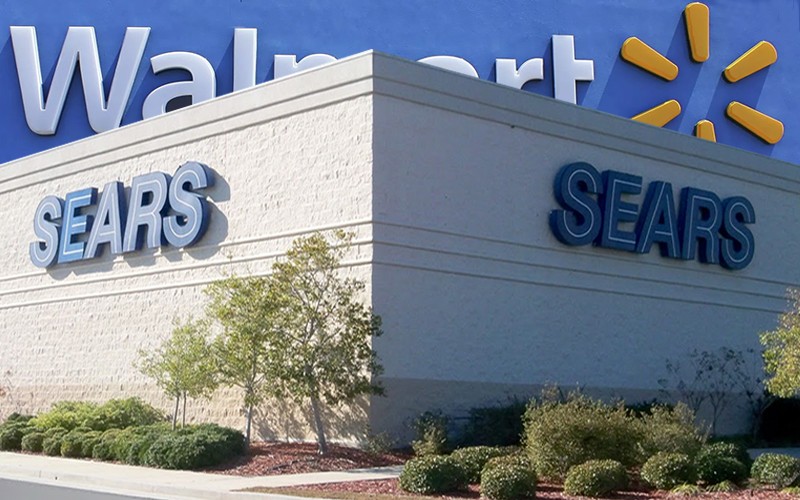What Traditional Lenders can Learn from Sears & Walmart

The divergence of digitization in commercial lending is comparable to the retail wars of the past three decades. Consider the paths of two retail giants in the late 20th century: Sears and Walmart.
Sears embraced traditional brick and mortar stores, and brand loyalty/equity (Diehard, Craftsman & Kenmore) with minimal investments in ecommerce. Walmart continued to maintain a strong brick and mortar presence, but invested billions in an ecommerce infrastructure to rival Amazon.
Today, the results of those two strategies couldn’t be clearer. In 2018, Walmart’s online sales grew 40%, while the company’s overall sales grew by 2.8%. At the same time, Sears was filing for Chapter 11 Bankruptcy.
A similar dynamic is playing out in the commercial lending space between fintechs and traditional lenders in terms of digitization. Some lenders will take the Walmart approach, while others will go the way of Sears. Here’s why.
Sears or Walmart? Digitization Determines the Difference.
Banks and other traditional lenders have been slow to move into digital spaces. Fintechs, however, predicted that the internetization of finance would eventually lead borrowers to prefer online lending. But without the resources of traditional banks, fintech lenders had to build a new underwriting strategy, targeting customers that traditional lenders either ignored or rejected.
To qualify underbanked borrowers with low or no credit scores, fintech lenders developed new underwriting methods based on cash flow analysis. Credit models based on borrower cash flow enabled fintechs to measure if and how an applicant could repay a loan with more precision.
Fintechs unlocked previously untapped markets in unsecured personal loans, SME lending, consumer mortgages, and auto loans. These cash flow models outperformed traditional analyses, particularly when paired with AI and machine learning algorithms, limiting losses from defaults while simultaneously widening the funnel.
Fintech lenders essentially had to reimagine all the underwriting processes that had grown stale at the banks. Fintech lenders had to identify potential liabilities quickly, so they developed rapid anti-fraud measures to spot altered financial documents and other malfeasance. They also had to constantly refine operations at the margins to keep customer acquisition and underwriting costs low. Any failed process could be the one that broke them, which is why the fintechs invested so much in developing these hyper-efficiencies.
Although fintechs were born in digital spaces, some of their core components were not initially digitized. For years, processes such as document review required human input. But the commitment of most fintechs to full digitization encouraged new innovations and third party solutions.
Just as Walmart went all in on ecommerce, fintechs went all in on digitization. Today, core underwriting processes that previously required humans, such as data entry, document review, and data validation, can be fully digitized. Solutions that employ AI, machine learning, and intertwined human quality control are quickly eliminating what non-digital processes remain.
When forced to make do with less, fintechs embraced digitization across all operations, creating efficiencies at every level of the lending process. The result was a loan origination process that was quicker, more accurate, more cost-effective, and more scalable than traditional methods. Where banks saw risky and unprofitable credit markets, emerging fintechs saw opportunities for innovation. In the process, fintechs developed lean and scalable digital-first platforms from the ground up.
Right now, banks and other traditional lenders are closer to Sears than they are to Walmart. Lenders that have only invested passingly in digitization have already gone the way of Sears. Between competition from fintechs, and new customer expectations for online services, the traditional lenders that are still in the game have all been forced to digitize rapidly in the last decade. But many traditional lenders do run the risk of entering Sears territory if they don’t reorient their digitization priorities in the near future.
Judging from the headlines, traditional lenders are starting to hear this message. J.P. Morgan, for instance, committed $10.8 billion to financial technology in 2018. But dig beneath the surface, and you’ll find potential trouble. Many large banks and other traditional lenders are now staking their digitization strategies primarily on customer-facing improvements, such as portals for submitting borrower information and uploading required documents.
Read an article about the bank digitization, and you’ll find that the “customer experience” is often considered the core objective. There’s talk about “experience stores” and on-demand “human touch.” What you likely won’t find is discussion about process digitization. The topic is prominently absent from the conversation. Just consider how AI is currently deployed by banks. Only 6.5% of AI spending in banking is allocated to back-office processes such as credit underwriting.
Improvements in the customer experience are highly visible and important. But they do nothing to digitize the under-the-hood capabilities that allow lenders to improve critical ROI metrics, such as application response time. Meanwhile, fintechs were born online, and have already fully digitized processes such as document capture and review with AI-infused technologies. Now fintechs are the side that has the structural and institutional advantage.
Choosing a Strategy: Sears or Walmart?
For traditional lenders, the stakes for digitization are high. By 2030, 80% of financial institutions will either go out of business or be rendered irrelevant by new competition, changing customer behaviour, and advancements in technology, according to forecasts by Gartner. The study also found that most financial institutions are now committed to digital “optimization” rather than “transformation.”
At one point, Sears made a choice between business as usual and transformation via ecommerce. Traditional lenders can read how that turned out in the company’s Chapter 11 bankruptcy filing. Meanwhile, some lenders, either through transformation or acquisition, are following the Walmart model of operational efficiency and ecommerce. The clock is already ticking for traditional lenders as they play catchup with more nimble fintech lenders.




